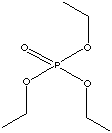TRIETHYL PHOSPHATE
PRODUCT IDENTIFICATION
78-40-0

182.16
H.S. CODE
TOXICITY
CLASSIFICATION
PHYSICAL AND CHEMICAL PROPERTIES
AUTOIGNITION
480 C
REFRACTIVE INDEX
APPLICATIONS
Phosphoric acid alkyl esters are also used as alkylation agent for nitrogen heterocyclic compounds and as catalysts to produce phenolic and urea resins. They are used flame retarding plasticizers for cellulose esters, lacquers, plastic and vinyl resins as well as as dispersing agents in plastisols. They are used as solvents in liquid-liquid extractants or separation agent of metals. They are is used as heat exchange media and as pigment grinding assistants and antifoam agents.
APPEARANCE
MOISTURE
0.2% max
ACID VALUE
0.05 max (mg KOH/g)
CHLORIDE
5ppm max
REFRACTIVE INDEX
COLOR (Pt-Co)
10 max
Class of Flame Retardants
- Inorganic
- Metal
hydroxides
- Aluminium hydroxide
- Magnesium hydroxide
- Orthers
- Antimony
compounds
- Antimony trioxide
- antimony pentoxide
- Sodium antimonate
- Others
- Boron
compounds
- Boric acid
- Borax
- Zinc borate
- Others
- Other metal
compounds
- Molybdenum compounds
- Titanium compounds
- Zirconium compounds
- Zinc
compounds
- Zinc stannate
- Zinc hydroxy-stannate
- Others
- Others
- Phosphorus
compounds
- Red phosphorus
- Ammonium polyphosphate
- Others
- Other
inorganic flame retardants
- ammonium sulfamate
- ammonium bromide
- Others
- Metal
hydroxides
- Halogenated
organic
- Brominated
- Tetrabromobisphenol A
- Decabromodiphenyl ether
- Octabromobiphenyl ether
- Tetrabromobiphenyl ether
- Hexabromocyclododecane
- Tribromophenol
- Bis(tribromophenoxy) ethane
- Tetrabromobisphenol A polycarbonate oligomers
- Tetrabromobisphenol A epoxy oligomers
- Others
- Chlorinated
- Chlorinated paraffins
- Bis(hexachlorocyclopentadieno)cyclo-octane
- Others
- Brominated
- Organophosphoros
- Non-halogenated compounds
- phosphate
esters
- Ttrialkyl phosphates
- Triaryl phosphates
- Aryl-alkyl phosphates
- Others
- polyols
- phosphonium derivatives
- phosphonates
- Others
- phosphate
esters
- Halogenated
phosphates
- Tris(1-chloro- 2-propyl) phosphate
- Tris(2-chloroethyl) phosphate
- Tris(2,3-dibromopropyl)phosphate
- Others
- Non-halogenated compounds
- Nitrogen-based
- Polyurethanes
- Polyamides
- Melamine and its salts
- Guanidine compounds
- Others